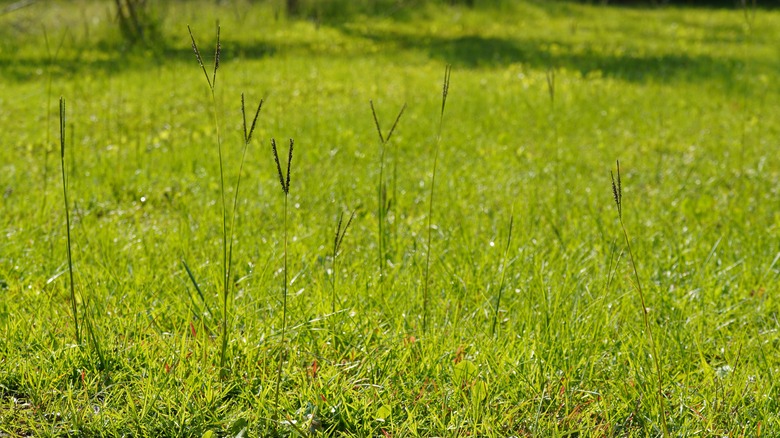Here's How To Cut Out The Invasive Bahiagrass That's Taking Over Your Lawn
While bahiagrass has many beneficial characteristics such as its drought tolerance, disease resilience, and resistance to close grazing, its invasive tendencies can far outweigh the benefits in certain parts of the country. Bahiagrass, with its distinctive Y-shaped seed head, is a warm season grass that was originally introduced in 1914 as a pasture grass in the southeastern United States. It flourishes in these areas — so much so, that the states of Georgia and South Carolina gave listed it as invasive. Fortunately, the grass can be removed by hand rouging, suppressed with organic mulches, and sprayed with herbicides.
The invasiveness of bahiagrass is thanks to the way it grows and its seed production. The roots of the grass are fibrous and grow deeply, which allow it to establish and spread rapidly. Additionally, bahiagrass is a prolific seed producer and its seeds are easily dispersed by the wind, humans, and animals creating the perfect storm for abundant growth.
How to remove bahiagrass in a few ways
There are two main options to choose from when deciding how to remove bahiagrass from your lawn. First, you can pull out the grass manually. Ensure that you do this when the soil is moist to make the grass easier to pull. But manually removing the grass likely isn't feasible on large lawn areas. This is where you may want to consider using an herbicide so that you can remove a larger area of grass. For this method, you'll want to identify the type of grass you have in your lawn, as some varieties of bahiagrass are more aggressive than others and may require different types of herbicides applied at different frequencies and amounts.
You can apply metsulfuron methyl to selectively remove patches of bahiagrass from your lawn. Glyphosate is also regularly recommended as another herbicide to eradicate bahiagrass. However, glyphosate products are non-selective so using them is one of the easiest ways to kill the grass in your lawn. It should also be noted that studies show glyphosate, commonly found in Roundup products, is linked to the development of cancer and should be taken into consideration when choosing an herbicide to apply to your lawn. Make sure you follow all label instructions and precautions when applying herbicides.
How to prevent bahiagrass from taking over your lawn
Eradication of bahiagrass isn't always realistic, so it may be more practical to focus on controlling the growth of the grass by mowing, mulching and by increasing the resilience of your native turf. Regularly mowing the bahiagrass will keep its growth low and prevent the grass from producing seeds. It's important to only mow the grass when seeds aren't displayed to avoid dispersing them among the rest of your lawn. Applying organic materials like compost, pine needles and ground leaves are some of the best kinds of mulch to suppress bahiagrass's growth.
As for increasing your native turf's overall resilience, make sure it's receiving proper fertilization and irrigation of your lawn, and make sure your soils stays healthy. All of these factors play a role in growing healthy grass. And the healthier your lawn is, the less vulnerable it is to bahiagrass invasions.


